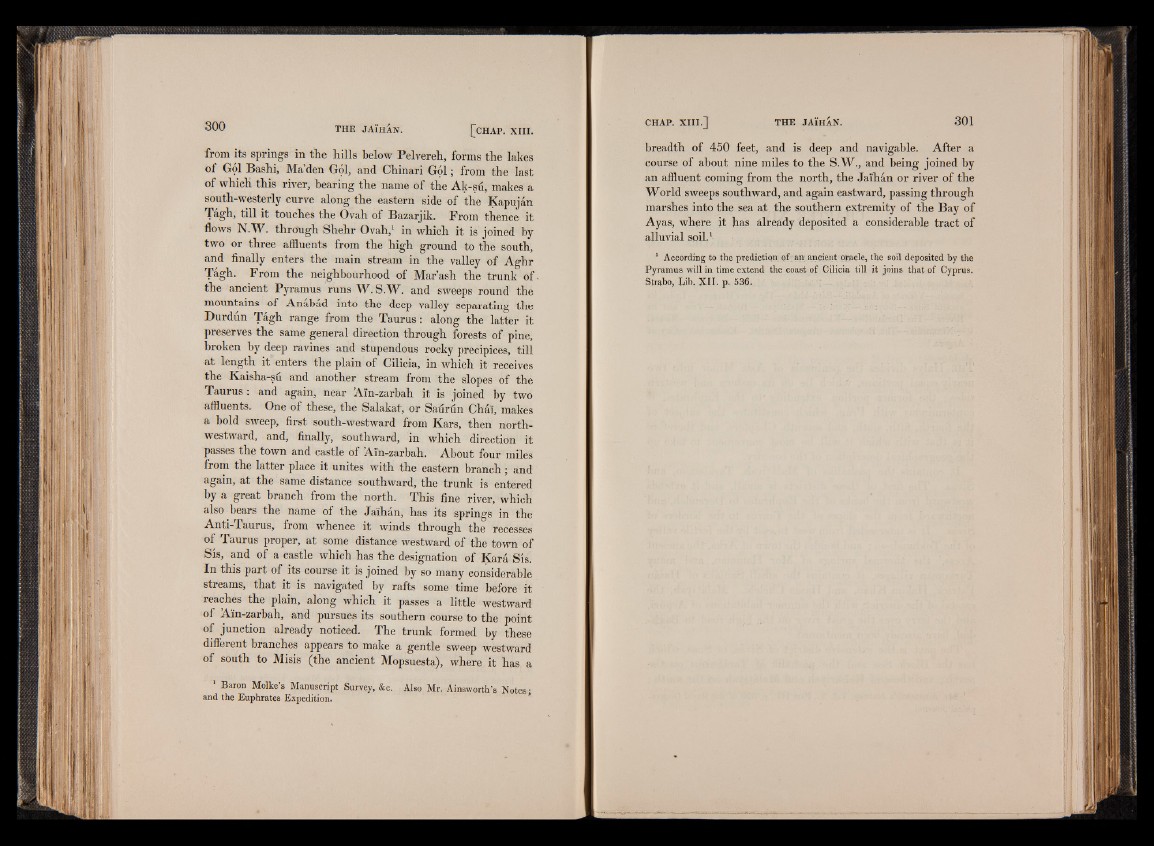
from its springs in the hills below Pelvereh, forms the lakes
of Gol Bashi, Ma den Gpl, and Chinari Gol; from the last
of which this river, bearing the name of the Ak-su, makes a
south-westerly curve along the eastern side of the Kapujan
Tagh, till it touches the Ovah of Bazarjik. From thence it
flows N.W. through Shehr Ovah,1 in which it is joined by
two or three affluents from the high ground to the south,
and finally enters the main stream in the valley of Aghr
Tagh. From the neighbourhood of Mar’ash the trunk of-
the ancient Pyramus runs W. S.W. and sweeps round the
mountains of Anabad into the deep valley separating the
Durdun Tagh range from the Taurus: along the latter it
preserves the same general direction through forests of pine,
broken by deep ravines and stupendous rocky precipices, till
at length it enters the plain of Cilicia, in which it receives
the Kaisha-su and another stream from the slopes of the
Taurus : and again, near Ain-zarbah it is joined by two
affluents. One of these, the Salakat, or Saurun Chai, makes
a bold sweep, first south-westward from Kars, then northwestward,
and, finally, southward, in which direction it
passes the town and castle of Ain-zarbah. About four miles
from the latter place it unites with the eastern branch; and
again, at the same distance southward, the trunk is entered
by a great branch from the north. This fine river, which
also bears the name of the Jaihan, has its springs in the
Anti-Taurus, from whence it winds through the recesses
of Taurus proper, at some distance westward of the town of
Sis, and of a castle which has the designation of Kara Sis.
In this part of its course it is joined by so many considerable
streams, that it is navigated by rafts some time before it
reaches the plain, along which it passes a little westward
of Ain-zarbah, and pursues its southern course to the point
of junction already noticed. The trunk formed by these
different branches appears to make a gentle sweep westward
of south to Misis (the ancient Mopsuesta), where it has a
1 Baron Molke’s Manuscript Survey, &c. Also Mr. Ainsworth’s Notes;
and the Euphrates Expedition.
breadth of 450 feet, and is deep and navigable. After a
course of about nine miles to the S.W., and being joined by
an affluent coming from the north, the Jaihan or river of the
World sweeps southward, and again eastward, passing through
marshes into the sea at the southern extremity of the Bay of
Ayas, where it has already deposited a considerable tract of
alluvial soil.1
1 According to the prediction of an ancient oracle, the soil deposited by the
Pyramus will in time extend the coast of Cilicia till it joins that of Cyprus.
Strabo, Bib, XII. p. 536.